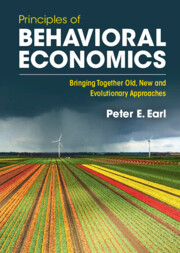Book contents
- Principles of Behavioral Economics
- Principles of Behavioral Economics
- Copyright page
- Contents
- Figures
- Tables
- Preface
- Acknowledgments
- 1 What Is Behavioral Economics?
- 2 What Motivates Us?
- 3 Why Is Life So Full of Problems for Us to Try to Solve?
- 4 How Do We Acknowledge Problems and Assess Options?
- 5 How Do We Deal with Uncertainty and Ambiguity?
- 6 How Do We Search for Solutions to Problems?
- 7 Why Do Some Things Matter More Than Others?
- 8 How Do We Choose?
- 9 How Can Firms and Governments Influence Our Choices?
- 10 What Determines the Productivity of an Organization?
- 11 How Does the Competitive Process Work?
- 12 Are There Any Behavioral Insights for Macroeconomists?
- 13 Can We Be Happy without Destroying the Environment?
- References
- Index
4 - How Do We Acknowledge Problems and Assess Options?
Published online by Cambridge University Press: 18 October 2022
- Principles of Behavioral Economics
- Principles of Behavioral Economics
- Copyright page
- Contents
- Figures
- Tables
- Preface
- Acknowledgments
- 1 What Is Behavioral Economics?
- 2 What Motivates Us?
- 3 Why Is Life So Full of Problems for Us to Try to Solve?
- 4 How Do We Acknowledge Problems and Assess Options?
- 5 How Do We Deal with Uncertainty and Ambiguity?
- 6 How Do We Search for Solutions to Problems?
- 7 Why Do Some Things Matter More Than Others?
- 8 How Do We Choose?
- 9 How Can Firms and Governments Influence Our Choices?
- 10 What Determines the Productivity of an Organization?
- 11 How Does the Competitive Process Work?
- 12 Are There Any Behavioral Insights for Macroeconomists?
- 13 Can We Be Happy without Destroying the Environment?
- References
- Index
Summary
Problems and potential solutions do not speak to themselves: people recognize them and size them up in an active process of cognition. The open-ended nature of problem-solving activities requires that our minds can avoid being paralyzed by several infinite regress problems that conventional economics overlooks. This chapter explores how people allocate their attention between implementing solutions to problems and scanning for new problems and how they judge whether incoming information signifies a problem. It draws parallels with how scientists and object recognition technologies operate via systems of rules, and it presents an original synthesis of Hayek’s theory of the mind (a forerunner to modern theories of brain plasticity), Kelly’s personal construct psychology, Koestler’s work on creativity, Simon’s theory of satisficing and the dual-system view of thinking, and of the role of associative memory processes suggested by Kahneman. The analysis explains how “what comes to mind” is determined as we try to find matches between incoming stimuli and templates from our memories and how we resolve cognitive dissonance between what we expect and what initially seems to be going on.
Keywords
- Type
- Chapter
- Information
- Principles of Behavioral EconomicsBringing Together Old, New and Evolutionary Approaches, pp. 81 - 118Publisher: Cambridge University PressPrint publication year: 2022

